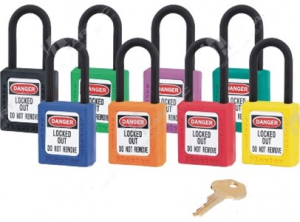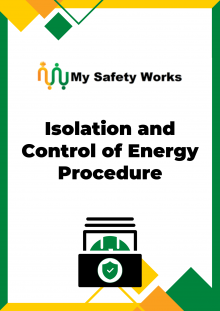Description
What is Isolation and Control of Energy Procedure?
Isolation and control of energy is the use of physical locks, tags and other means to isolate hazardous energy sources and prevent unexpected start-up of machinery or release of stored energy.
Employers are required to establish procedures for controlling hazardous energy and protecting workers from injuries resulting from the release of that energy.
What are Isolation and Control of Energy Procedures?
An isolation and control of energy procedure is a written document that provides instructions and guidelines for safety, the protection of workers and the control of energy.
The procedure’s intent is to prevent an uncontrolled energy release that would present a risk to a person or equipment.
Isolation and Control of Energy Steps and Processes
Below are the essential steps that must be considered and followed, as is necessary, for the safe isolation and control of energy.

Step 1. Identify the Hazardous Energy Source
Assess the types of hazardous energy and the magnitude and determine suitable methods of lockout and tag out to control the hazardous energies of the machines or equipment.
Step 2. Notify All Affected Parties
The person authorising the work must notify all affected employees and parties (e.g. management, supervision, operators and workers in the area) of:
- The specific procedural scope of work that will be conducted.
- The systems of isolation, circuit breaker or tagout devices being used.
- The requirement is not to disturb or attempt to restart the equipment until the work is completed, the isolation devices are removed and it is safe to resume normal operations.
Note: Isolation and control of energy must only be carried out to the level of a person’s competence and authorisation. Refer to and always comply with any specific equipment procedures in relation to isolations.
Step 3. Shut Down the Equipment
If the equipment is operating, the person authorising the work must verify that it is safe to shut down. The equipment can then be stopped using the established methods and procedures for that item of equipment.
Step 4. Isolate, Dissipate and Restrain All Energy Sources
Isolation of energy sources should be completed by physically interrupting the supply of energy. This can be achieved by measures including:
- Turning off power switches in electrical circuits.
- Closing supply valves.
- Removing mechanical drives.
- Disconnecting batteries, leads, cables or hoses.
- Blanking off pipelines.
The means of isolation should be of a type that can be readily checked by a visual inspection and it should act directly on the supply line. It should not act through control circuits or emergency stop mechanisms.
After the energy sources are isolated, any stored energy in the equipment should be dissipated. This can be achieved by measures including:
- Opening valves to drain pipelines, pressure vessels and hydraulic accumulators.
- Opening access hatches and inspection covers.
- Earthing electrostatic separators.
- Releasing springs.
- Lowering counterweights.
- Purging process lines.
Note: The method of energy dissipation must ensure that energy does not re-accumulate over time, or during work.
If internal sources of energy cannot be dissipated, they must be adequately restrained by measures such as:
- Inserting mechanical locking devices such as chocks or pins.
- Securing items that can move, such as fans and mechanical linkages with chains.
- Closing cover plates on radioactive gauges.
- Applying brakes.
Step 5. Secure and Identify Isolation Devices (Lock-Out and Tag-Out)
Each of the lockout devices or energy isolating devices used to isolate, dissipate and restrain energy sources must be secured and identified in accordance with the risk management hierarchy of controls to prevent inadvertent energizing or release of energy.

Securing Isolation Devices (Lock-Out)

Where practicable, the isolation device must be secured by a lock to provide assurance that:
- The isolation device cannot be inadvertently removed.
- The person who applied the isolation device is the only person who can remove the isolation device.
When more than one person is working on the same equipment, each person working on the equipment should have their own lock, key and tag, a multi-lock hasp, or group lock box may be used.
There should be no duplicate key available for any lock, except a master or duplicate key for use in an emergency that is secured and not readily available.
In cases where isolation devices are not capable of being locked out, a ‘tag-out only’ procedure may be used if:
- There is a justifiable and verifiable reason why a lock-out procedure cannot be applied.
- The alternative method of securing the isolators offers the persons working on the equipment an equivalent level of protection.
- Formal approval is obtained from a manager or supervisor.
Step 6. Verify the Effectiveness of the Energy Controls
The person authorizing the work must ensure that competent persons verify that all hazardous energies have been effectively isolated, dissipated or restrained.
Note: If the equipment that is being worked on is not ready for operation or testing by the end of the shift, then all locks and tags must be systematically removed and replaced with ‘Out of Service Tags’ and all necessary details completed.
Step 7. Complete the Work and Confirm Completion
As each person completes their work on the equipment they must:
- Clear the work area of any tools or materials that they have used that are not required by other people still working on the equipment.
- Replace any guards that are not required to be left open for access by other people still working on the equipment.
- Restore and verify all safety devices that have been removed or bypassed.
- Report the completion of the work to the person in charge of the equipment (or their nominated supervisor).
Step 8. Remove the Isolation Devices (Locks and Tags)
After confirming the completion of work, each person must remove their personal isolation locks and isolation tags.
Step 9. Confirm the Return to Service and Start-Up
Before removing the last isolation locks and tags, the person responsible for re-energising the equipment must ensure:
- All work has been successfully completed.
- The equipment is clear of any tools and materials.
- All guards and safety equipment have been replaced and are in good working order.
- When the equipment is fit for use, it must be restarted in accordance with the standard operating procedures or manufacturer’s instructions.
Contents of this Isolation and Control of Energy Procedure
- Approval.
- Purpose.
- Scope.
- Terms and Definitions.
- Roles and Responsibilities.
- Overview.
- Isolation and Control of Energy Procedure.
- Related Procedures, Forms and Documents.
- Review Criteria.
- Record Management.
- References.
Why Choose to Buy this Isolation and Control of Energy Procedure
- This 10-page isolation and control of energy procedure can assist you in specifying the requirements for the control of energy when performing servicing or maintenance tasks.
- When this procedure is successfully implemented, you will reduce the risk of harm to personnel and meet the requirements of legislated obligations.
After purchasing this isolation and control of energy procedure you will be able to:
- Very easily edit and customize the template to create your own isolation and control of energy procedure.
- Apply your own style, format and brand to the procedure.
- Use it in any industry or sector regardless of the size or type of organization.
Availability and Use of this Isolation and Control of Energy Procedure
- This isolation and control of energy procedure is accessible to you right now by clicking the ‘Buy Now’ button.
- The procedure will be delivered to you in fully editable Microsoft Word format for immediate and full use in your business.
- There are no subscriptions, contracts or ongoing costs.

This isolation and control of energy procedure is 100% satisfaction guaranteed.
You may also require:




